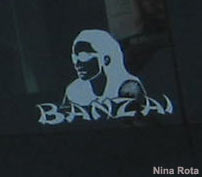Bill Tilden, the brilliant tennis player who dominated the game in the 1920’s, did live in New York, he had rooms at the Algonquin don’t you know, but the New Yorker is also the name of the venerable magazine which is eighty years old this year. The Complete New Yorker, an eight DVD set of every issue from 1925, the first year, to February 14, 2005, has just been released. I pre-ordered it from amazon.com so I could get my hands on it as soon as possible. Who needs the library any more? I can open the search menu and research to my heart’s content.
John K. Winkler wrote a profile of Bill Tilden in the September 18, 1926 issue. The article is an interesting comment on the mores of the time and the writing style as well as tennis history. Tilden, thirty-three at the time, had won six straight US singles championships and led the US to six consecutive Davis Cup victories and was about to lead it to a seventh.
Winkler interviews Tilden in his room at the Algonquin as he is preparing to shift his focus away from tennis and into writing plays and performing in them. Winkler bemoans the situation with a slightly overblown but certainly literary lament, “Soon (would I could drown the very thought) the rhythm and the beauty of his startling flashes of speed, Wagnerian service aces, and heart-halting rallies may be permanently submerged.”
Winkler surely knew that Tilden was gay, it was openly known in tennis circles though not by the public. Homosexuality was not an open subject in the 1920’s and Winkler uses code words and characterizations typical of the attempt to broach the subject without really broaching it. He describes Tilden as “Intimate with none,” an “acetylene-eyed solitary”, and “a lone antagonist of destiny.” There was truth to the characterization. Tilden had been orphaned at an early age and raised by a maiden, it was important to point out, aunt. And he had developed his exceptional tennis game without the benefit of ever having a lesson from a professional tennis instructor.
But this is also how you describe a gay man or woman. They can’t be intimate with anyone because they’re not allowed to be. Before she came out, Rosie O’Donnell appeared in a magazine as a single mother who prized self-sufficiency even though she has a partner who plays a large role in her childrens’ lives. You’d never know that Jodie Foster has ever had sex in her life. She is eternally un-partnered.
On the other hand, Winkler refers to writer Samuel Merwin as Tilden’s “most constant companion”, see what I mean by code words, and denotes the time of year by calling it “the fag end of July.” He was either having fun with us there or I’ve been reading too much literary theory.
… Winkler refers to writer Samuel Merwin as Tilden’s “most constant companion”, see what I mean by code words, and denotes the time of year by calling it “the fag end of July.”
Tilden changed his mind about shifting his vocation to the theater. A loss to protégée Vinnie Richards stoked his competitiveness enough to switch his focus back to tennis though he continued to write plays and appear on stage and in movies throughout his life.
Tilden was the Roger Federer of his day. He had a powerful serve he could use on critical points. He spun an array of tactical strategies using slices, powerful strokes, lobs and drops shots to undo his opponent. He loved neutralizing big servers with highly angled returns and passing shots. When he lost the top third of his middle finger on his racket hand to an infection, he remade his game to play more aggressively so he could shorten the rallies.
Unlike Federer but typical of a performer, he was also a drama queen. Tilden was flamboyant on the court and opponents suspected that he threw opening sets to make the match more entertaining and give the audience what it paid for.
At the end of the article, Tilden explains that we would rather give lessons to promising junior players free of change than join the professional tennis circuit and make a lot of money. The grand slam tournaments were limited to amateur players at the time. Winkler points out that Tilden sometimes chose to play doubles in important tournaments with junior players.
Tilden changed his mind and turned professional in 1931. His interest in junior boys prefigured troubles to come. In 1946 he was arrested for having sex with a teenage male prostitute and served seven months in jail. He was arrested again in 1949 on the same charge and spent ten months in jail.
It’s a statement of his brilliance as a tennis player that even after serving two jail terms on morals charges, he was voted the top tennis player of the first half of the century soon after he was released from jail for a second time.

